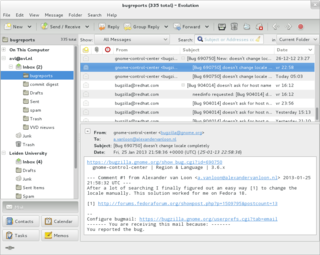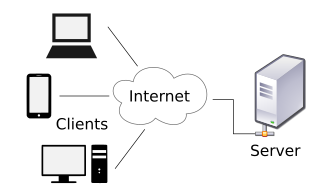Related Research Articles

Electronic mail is a method of exchanging messages ("mail") between people using electronic devices. Email was thus conceived as the electronic (digital) version of, or counterpart to, mail, at a time when "mail" meant only physical mail. Email later became a ubiquitous communication medium, to the point that in current use, an email address is often treated as a basic and necessary part of many processes in business, commerce, government, education, entertainment, and other spheres of daily life in most countries. Email is the medium, and each message sent therewith is called an email.

The Internet is the global system of interconnected computer networks that uses the Internet protocol suite (TCP/IP) to communicate between networks and devices. It is a network of networks that consists of private, public, academic, business, and government networks of local to global scope, linked by a broad array of electronic, wireless, and optical networking technologies. The Internet carries a vast range of information resources and services, such as the inter-linked hypertext documents and applications of the World Wide Web (WWW), electronic mail, telephony, and file sharing.

An intranet is a computer network for sharing information, easier communication, collaboration tools, operational systems, and other computing services within an organization, usually to the exclusion of access by outsiders. The term is used in contrast to public networks, such as the Internet, but uses most of the same technology based on the Internet protocol suite.

In computing, a server is a piece of computer hardware or software that provides functionality for other programs or devices, called "clients". This architecture is called the client–server model. Servers can provide various functionalities, often called "services", such as sharing data or resources among multiple clients, or performing computation for a client. A single server can serve multiple clients, and a single client can use multiple servers. A client process may run on the same device or may connect over a network to a server on a different device. Typical servers are database servers, file servers, mail servers, print servers, web servers, game servers, and application servers.

Instant messaging (IM) technology is a type of online chat allowing real-time text transmission over the Internet or another computer network. Messages are typically transmitted between two or more parties, when each user inputs text and triggers a transmission to the recipient(s), who are all connected on a common network. It differs from email in that conversations over instant messaging happen in real-time. Most modern IM applications use push technology and also add other features such as emojis, file transfer, chatbots, voice over IP, or video chat capabilities.
A virtual private network (VPN) extends a private network across a public network and enables users to send and receive data across shared or public networks as if their computing devices were directly connected to the private network. The benefits of a VPN include increases in functionality, security, and management of the private network. It provides access to resources that are inaccessible on the public network and is typically used for remote workers. Encryption is common, although not an inherent part of a VPN connection.

A web application is application software that runs in a web browser, unlike software programs that run locally and natively on the operating system (OS) of the device. Web applications are delivered on the World Wide Web to users with an active network connection.
An application program is a computer program designed to carry out a specific task other than one relating to the operation of the computer itself, typically to be used by end-users. Word processors, media players, and accounting software are examples. The collective noun "application software" refers to all applications collectively. The other principal classifications of software are system software, relating to the operation of the computer, and utility software ("utilities").
Calendaring Extensions to WebDAV, or CalDAV, is an Internet standard allowing a client to access and manage calendar data along with the ability to schedule meetings with users on the same or on remote servers. It lets multiple users in different locations to share, search and synchronize calendar data. It extends the WebDAV specification and uses the iCalendar format for the calendar data. The access protocol is defined by RFC 4791. Extensions to CalDAV for scheduling are standardized as RFC 6638. The protocol is used by many important open-source applications.
Mobile app development is the act or process by which a mobile app is developed for mobile devices, such as personal digital assistants, enterprise digital assistants or mobile phones. These software applications are designed to run on mobile devices, such as a smartphone or tablet computer. These applications can be pre-installed on phones during manufacturing platforms, or delivered as web applications using server-side or client-side processing to provide an "application-like" experience within a web browser. Application software developers also must consider a long array of screen sizes, hardware specifications, and configurations because of intense competition in mobile software and changes within each of the platforms. Mobile app development has been steadily growing, in revenues and jobs created. A 2013 analyst report estimates there are 529,000 direct app economy jobs within the EU then 28 members, 60 percent of which are mobile app developers.
Mobile device management (MDM) is the administration of mobile devices, such as smartphones, tablet computers, and laptops. MDM is usually implemented with the use of a third-party product that has management features for particular vendors of mobile devices. Though closely related to Enterprise Mobility Management and Unified Endpoint Management, MDM differs slightly from both: unlike MDM, EMM includes mobile information management, BYOD, mobile application management and mobile content management, whereas UEM provides device management for endpoints like desktops, printers, IoT devices, and wearables as well.
Consumerization is the reorientation of product and service designs to focus on the end user as an individual consumer, in contrast with an earlier era of only organization-oriented offerings. Technologies whose first commercialization was at the inter-organization level thus have potential for later consumerization. The emergence of the individual consumer as the primary driver of product and service design is most commonly associated with the IT industry, as large business and government organizations dominated the early decades of computer usage and development. Thus the microcomputer revolution, in which electronic computing moved from exclusively enterprise and government use to include personal computing, is a cardinal example of consumerization. But many technology-based products, such as calculators and mobile phones, have also had their origins in business markets, and only over time did they become dominated by high-volume consumer usage, as these products commoditized and prices fell. An example of enterprise software that became consumer software is optical character recognition software, which originated with banks and postal systems but eventually became personal productivity software.
Mobile Business Intelligence is defined as “Mobile BI is a system comprising both technical and organizational elements that present historical and/or real-time information to its users for analysis on mobile devices such as smartphones and tablets, to enable effective decision-making and management support, for the overall purpose of increasing firm performance.”. Business intelligence (BI) refers to computer-based techniques used in spotting, digging-out, and analyzing business data, such as sales revenue by products and/or departments or associated costs and incomes.
Mobile application management (MAM) describes the software and services responsible for provisioning and controlling access to internally developed and commercially available mobile apps used in business settings, on both company-provided and 'bring your own' mobile operating systems as used on smartphones and tablet computers.
A mobile application or app is a computer program or software application designed to run on a mobile device such as a phone, tablet, or watch. Mobile applications often stand in contrast to desktop applications which are designed to run on desktop computers, and web applications which run in mobile web browsers rather than directly on the mobile device.
Bring your own device —also called bring your own technology (BYOT), bring your own phone (BYOP), and bring your own personal computer (BYOPC)—refers to being allowed to use one's personally owned device, rather than being required to use an officially provided device.
A mobile workspace is a user’s portable working environment that gives them access to the applications, files and services they need to do their job no matter where they are.
Remote mobile virtualization, like its counterpart desktop virtualization, is a technology that separates operating systems and applications from the client devices that access them. However, while desktop virtualization allows users to remotely access Windows desktops and applications, remote mobile virtualization offers remote access to mobile operating systems such as Android.
Mobile procurement is mobile business software that helps organizations streamline their procurement process from a mobile device. Features of mobile procurement software include mobile purchase order creation, on-demand notifications, and real-time analytics. What makes mobile procurement successful is the ability to leverage software-side servers to move data along. The key benefit for organizations using mobile procurement systems is the ability to track business operations using any ordinary mobile device.

Microsoft 365 is a product family of productivity software and cloud-based services owned by Microsoft. It encompasses online services such as Outlook.com, OneDrive, Microsoft Teams, programs formerly marketed under the name Microsoft Office, enterprise products and services associated with these products such as Exchange Server, SharePoint, and Yammer, and subscription plans encompassing these products.
References
- ↑ Stieglitz, S. & Brockmann, T. (2012). "Increasing Organizational Performance by Transforming into a Mobile Enterprise. MIS Quarterly Executive (MISQE), 11(4), 2012, 189-204". AIS.
- ↑ bfrench (January 5, 2011). "Survey: Mobile Apps Increase Enterprise Performance and Productivity Advantages, Top Three Mobile App Strategies Gain Momentum". iPad CTO.
- ↑ Leighton (July 2011). "Productivity Benefits of Mobile". CRM Guidebooks.